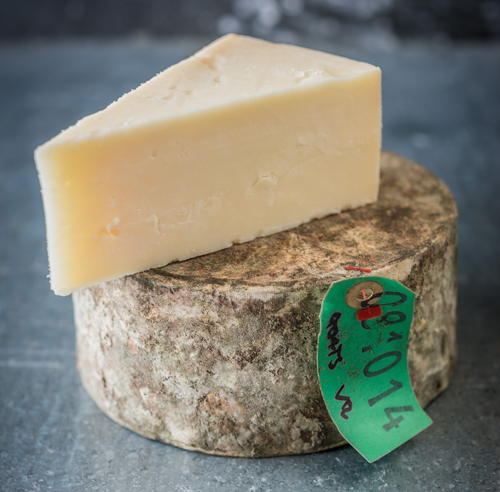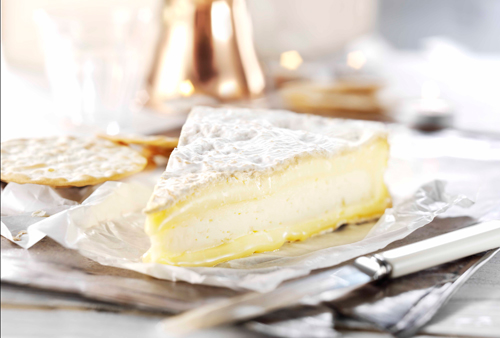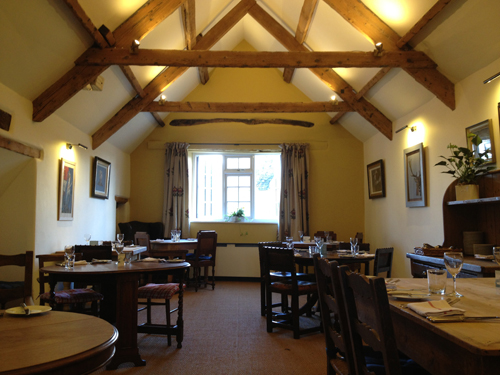Whipping up a storm: the resurgence of dairy
With the likes of artisan cheeses, goats' milk curd, ash logs and gourmet butters all making waves in food circles, the dairy industry is experiencing a genuine renaissance, as Hannah Thompson finds out
For products whose processes are centuries old, cheese and dairy are having their moment in the spotlight. From raw milk to new cheeses or the rediscovery of the classics, the sector is experiencing a surge in interest that takes it far beyond the cheeseboard.
Quicke's
Producers such as Quicke's, based in Devon, are a good example. The land where the farm stands has a history of farming and dairy production that goes back to before 1540 and Henry VIII's dissolution of the monasteries. It is now overseen by descendent Mary Quicke, who began cheesemaking here 40 years ago. It's still very much a family endeavour, and its cheeses are well-known for their distinctive taste and unmatched quality.
Tom Chatfield, sales manager at Quicke's, believes this history is central to the farm's ethos. "It creates a rich integrity to the brand," he says. "The core aim is to retain the land and farm, look after it and not exploit it. People now want something that speaks of where it's from, and chefs enjoy having that rich story to tell."
Mary Quicke
As purveyors of fine, cloth-bound cheddars, it is fitting that the home-grown Quicke's, with its compelling pedigree, has also made strides into another new trend: goats' milk.
Quicke's is the only British producer making a hard goats' cheese (alongside an oak-smoked variety), and it has created a wonderfully fresh-tasting product. The cheese, which has an unmistakable regional flavour, is matured for six months and has such a clean flavour that it could almost work as a palate cleanser.
Quickes Clothbound Cheddar
Getting the goat
Indeed, often considered a purely French institution, goats' milk and cheese has now very much returned to Great Britain and Ireland, with products such as goats' milk curd proving that chefs are making the most of the products' new and delicious characteristics.
Owen Davies, category manager at Cheese Cellar for wholesaler and producer Harvey & Brockless, says: "We've been using more goats' cheese than was forecasted, which shows its popularity. We've also been producing goats' milk curd, which is a bit of a 'cheffy' product. Chefs use it in canapes and tarts, and it's a lighter way of using cheese without a cheeseboard."
Chefs, as ever, are certainly key to driving new trends and supporting high-quality dairy products. As Jason Hinds, sales director at wholesalers Neal's Yard, explains: "There is definitely a school of young, bright, avant-garde British chefs who are looking to innovate and find new ways of using ingredients that are closer to home, and there is a lot of experimentation going on at the moment."
St Tola
One product to highlight when it comes to goats, chefs and high-end trends must be St Tola in County Clare, Ireland. Family-run to its core and distributed by key wholesalers across the UK and Ireland, this tiny farm - producing 20 tonnes of cheese a year with only five full-time staff - is overseen by SiobhÁ¡n NÁ GhÁ¡irbith, who feels passionately about the part small-batch cheeses can play and their contribution to the dairy industry as a whole.
"The farm is a lifestyle choice," she says. "Our production levels are small and our costs are high, but we continue to try and improve and maintain our high standard. We supply the top end of the food market, and work very closely with our customers, top-end chefs, suppliers and cheese retailers, so we can listen to what they want."
St Tola is also an example of a farm continually searching for new trends and products to please wholesalers and chefs. "Our ash log is a real winner," NÁ GhÁ¡irbith says. "I originally made it during a quiet time on the farm in January 2013 - the others now dread when I get bored in case I have another mad idea. When it is very young and fresh, the cheese is hand-rolled in ash, which is actually a food-grade charcoal. After a few weeks of maturing, an elegant, smooth-textured cheese emerges. For us it's about quality, not quantity."
Fen Farm Dairy
Indeed, British and Irish producers are widely reclaiming a cheese heritage that in past decades may have looked doomed. The highly-acclaimed Fen Farm Dairy in Suffolk, owned by Jonny and Dulcie Crickmore, produces a Brie-style Baron Bigod which is making considerable waves with cheese connoisseurs, despite being just two years in production.
A real trailblazer of a product, it is made using unpasteurised cows' milk - an additional great champion of today's new dairy trends - which is carefully maintained from the cows' spotless teats onwards to ensure its cleanliness and healthiness.
The result is a delicately flavoured Brie with a taste and texture that has ensured its recommendation from top wholesalers, and its place on the menus of produce-conscious restaurants, such as London-site Roast, in the city's illustrious Borough Market, which lists Baron Bigod as one of three cheeses made from unpasteurised milk on its cheese menu (the others are Appleby's Cheshire from Shropshire, and Tymsboro goats' cheese from Mary Holbrook in Somerset).
Jonny and Dulcie Crickmore of Fen Farm Dairy and family
"Our Brie is unique to our farm," explains Jonny. "You can't make it anywhere else; we have all the good bacteria and levels of yeast that only occur here. The skill lies in keeping that good bacteria in, and the bad out."
Explaining the use of raw milk, he says: "You need a good base to make a good product. Our milk has an intense flavour - dense and silky. I'd like to think that there isn't another Brie that tastes quite like ours." As Davies from Harvey & Brockless says: "Once you've tasted raw milk, you never want to go back. It's got a richness; it's creamier, but not heavier."
Leaving taste aside, it's key to point out that the revival in interest in fresh, unfettered dairy has also been linked to new health trends.
Baron Bigod Brie by Fen Farm Dairy
Fat can be good
Fat is no longer as demonised as it was, and fat-rich, high-quality products are beginning to take centre stage across menus as diners wake up to the fact that fat isn't necessarily all bad. This is shown especially through the revival in interest in quality, gourmet butters, such as the French icons Lescure and Echiré, and brands closer to home, such as Irish farmhouse variety Cuinneog.
Whey butter is a particular favourite. As Chatfield from Quicke's explains: "There's so much flavour available. [Local food advocate association] Slow Food has selected whey butter as a 'forgotten food' that needs re-highlighting, and there's a lot of growing interest."
Much of this has arguably come from chefs such as Brett Graham from the Ledbury, who is purported to be a big fan, while the Square, Phil Howard's two-Michelin-starred restaurant overseen by head chef Gary Foulkes, is also said to have asked Quicke's to trial a smoked cows' whey butter, which the farm has discovered requires using frozen butter to reduce melting during the smoking process. "It's been very well-received," says Chatfield.
Artisan or not?
With such a focus on small producers and a revisiting of traditional techniques, it's unsurprising that when it comes to dairy, the word "artisan" is never far away. As vague as it is commonplace, the epithet is widely disputed, with some dismissing it as meaningless, and others embracing it as wholly appropriate. Is this dairy revival really an "artisan" revival?
Jason Hinds from Neal's Yard is cautious. He acknowledges the central importance of smaller producers and the stories behind them, but is unsure about the word "artisan" itself. "I think it's ugly," he says. "It's used by a lot of people who think it's romantic, but I think it can hide a lack of understanding. It's a fluffy word. It creates this image in the mind of the consumer to help sell something, but it can sometimes be very bogus."
Harvey & Brockless, however, have no problem with the term, and would agree that it's representative of the new surge in dairy interest. Davies explains: "Artisan is about respect for traditional processes, and about supporting farmers who have their own herd or who buy locally. They may have expanded or modernised their facilities, but they still keep within traditional methods. People nowadays are more knowledgeable about how things are made; they want to know. Artisan means the core of the recipe remains the same."
Emily Watkins of the Kingham Plough says it's "an acceptable term. People who put a lot of time, effort and skill into their products need to be recognised. They might not say they're 'artisan', but they deserve that label. Over the last few years there has been a massive increase in the visibility of artisan producer skills."
Jonny Crickmore agrees: "I think [the word artisan] is right. Our cheese has come from us putting our own touch on it; we've created this piece of food and no-one can recreate it. All the products have an artisan, unique bit to them."
Indeed, many say the new enthusiasm for British dairy is simply a re-discovery of existing processes; a much-overdue celebration of long-held practices and beliefs. It seems that dairy is quietly encapsulating all that is great about British and Irish heritage. As Crickmore summarises: "I don't know where it's going to go, but it feels like a movement. I think it's really exciting to be in the dairy industry right now."
Case study: the Kingham Plough
Emily Watkins, chef-proprietor at the Kingham Plough in Oxfordshire, is a strong advocate for high-quality, full-fat dairy, largely for its health benefits as much as flavour.
She only uses milk from family-owned local producers Nell's Dairy at Eyford Hill Farm, and feels strongly about its health qualities, which she and Eyford Hill estate co-owner Adam Fleming (with wife Caroline Fleming), believe can address a host of other complaints as well. From Guernsey cows fed on grass and silage, Nell's milk - which is available locally from milk vending machines - contains the A2 protein often found to be less of an irritant to people who suffer from dairy intolerance than the A1 variety found in supermarket-style cow's milk.
A2 milk is said to help clear up stomach gripes, eczema and dairy-related acne, while it is also claimed that the milk's boosted levels of vitamins, good fats and Omega 3 help everything from bone strength to cholesterol levels, eye clarity and brain health.
Watkins talked me through one of her desserts, which includes Guernsey milk and borage honey jelly, blackberry syrup, honey purée, blackberry granita, honeycomb and an almond tuile.
The use of non-homogenised milk, where the cream floats on the surface, is key: "It's got such flavour, it's a proper ingredient, it's not just a vehicle for something else. It's got a depth, it's sweet and it has body. It's like using stock as opposed to water, for a sauce. It adds incredible background, and it's important to tell the milk's story."
Watkins also sometimes uses the milk to make butter and cheese, and a range of seasonal ice-creams of which the custard variety uses over 70% of Nell's milk. "If the milk's not good, the ice cream's not good," she says.

















